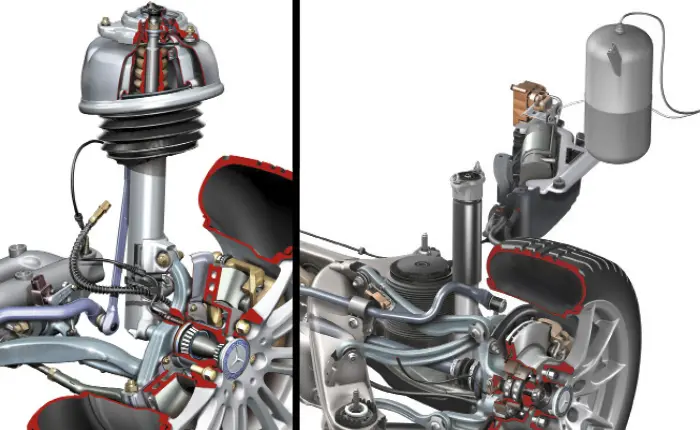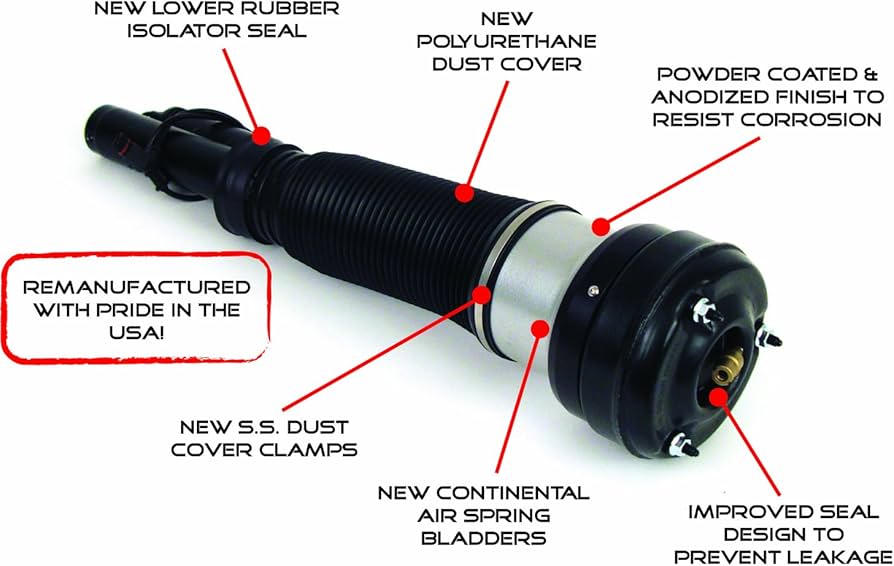Mercedes air suspension issues can feel overwhelming, but they’re manageable with the right know-how. Problems like leaky air struts or a faulty compressor are common and fixable. This guide breaks down each issue and offers simple solutions to get your Mercedes back to a smooth ride. Let’s explore how to spot and solve these problems to keep your car in top shape.
What Is a Mercedes Air Suspension System?
Mercedes air suspension systems, like the AIRMATIC, use air-filled springs and smart technology to make your ride smooth and comfortable. They adjust to road bumps, heavy loads, or driving style, giving you control over how your car feels—whether you want a soft cruise or sporty handling.

Key Parts of the Air Suspension
The air suspension has a few important pieces. Air springs act like cushions, filling with air to support the car. Air struts combine air springs with shock absorbers for a stable ride. The air compressor pumps air to keep the car at the right height. Level sensors check the car’s height and tell the system when to adjust. A control unit ties it all together, making sure everything works in harmony.
How AIRMATIC Works
The AIRMATIC system is Mercedes’ high-tech air suspension. It uses air springs and electronic controls to fine-tune your ride. The air compressor keeps air pressure just right, while level sensors monitor the car’s height to adjust for bumps or turns. You can switch between comfy or sporty modes, making rough roads feel smoother or highways more responsive.
AIRMATIC vs. Regular Suspensions
Unlike traditional suspensions with metal coil springs, AIRMATIC uses air springs for better comfort and flexibility. Regular setups use coil springs and shocks that can’t adjust as easily. AIRMATIC lets you tweak settings for a plush ride or sharp handling, and it can raise or lower the car to handle heavy loads or improve speed efficiency.
Typical Mercedes Air Suspension Problems
Air suspension issues in Mercedes cars can mess with comfort, handling, or even safety. Here are the most common problems you might run into.
Air Compressor Troubles
The air compressor keeps your car at the right height by pumping air into the system. If it breaks, your car might lean to one side or sit too low. You could hear odd noises, like grinding, when it’s struggling. Dashboard warning lights might also pop up.
Wear and tear or bad wiring often cause compressor issues. Regular checkups can catch small problems early. If the compressor is failing, get it checked—it’s pricey to replace, but driving with a broken one isn’t safe.

Leaky Air Struts or Springs
Older Mercedes models often get leaks in air struts or springs. The rubber parts can crack or tear, letting air escape. You might notice your car sagging after sitting overnight or hear a hissing sound from leaking air.
Leaks make rides bumpy and can damage other parts if ignored. Check rubber components regularly and replace any worn parts to avoid bigger headaches.
Ride Height and Sensor Issues
Level sensors help your car stay balanced by tracking its height. If they fail, your car might not adjust properly, leading to uneven or uncomfortable rides. Warning lights could signal sensor problems, often caused by electrical glitches or damage.
Fixing sensors can be tricky and may need special tools. Routine maintenance keeps them working and prevents sudden failures.
Control Unit Failures
The control unit is the brain of the air suspension. If it acts up, you might see warning lights, uneven height, or the compressor running too often. Software bugs or electrical issues are common culprits.
A faulty control unit can wear out other parts faster. Keep its software updated and have a technician check it regularly to keep your system reliable.
How to Fix AIRMATIC Suspension Problems
Fixing AIRMATIC issues, like compressor failures or leaks, can boost your car’s performance and make it last longer. Here’s how to tackle common repairs.
Replacing a Broken Air Compressor or Relay
If the air compressor stops working, first check the relay—it’s a small part that controls the compressor. Replacing a bad relay is cheaper than a new compressor. If the compressor itself is shot, you might need a new one, though rebuilding it with a new piston and desiccant can save cash.
Repairing Air Leaks in Struts or Bags
Air leaks in struts or bags can make your car sag or ride rough. Look for worn or torn rubber parts and listen for hissing. Small leaks can be patched, but bigger ones need new struts or bags. Fix leaks quickly to protect the rest of the system.

Calibrating Sensors for Proper Leveling
If your car feels uneven or wobbly, the level sensors might need recalibration. These sensors keep the car balanced, and misalignment can mess up handling. Special diagnostic tools are often needed to fix them, so a pro can help ensure your ride is safe and smooth.
Keeping Your AIRMATIC Suspension in Great Shape
Regular care for your Mercedes AIRMATIC system prevents pricey repairs and keeps rides comfortable. Simple checks and tweaks can make a big difference.
Maintenance Tips for Longevity
Check for leaks in air struts and springs—look for sagging or hissing sounds. A leaky strut can cause bigger issues if ignored. Also, test the air compressor to make sure it’s pumping air properly. If it’s slow, it might need attention.
Inspect the compressor’s fuse and relay, which are listed in your car’s manual. Replace them if they’re worn out. These small steps can stop problems before they grow.
Adjusting Ride Height for Comfort
You can tweak your car’s ride height for better comfort or handling. Check your model’s manual (like for the W220 S-Class) to find the controls. Adjust the rear height sensor’s link to raise or lower the car by up to two inches.
Make small changes, test drive, and recalibrate to ensure everything’s balanced. This keeps your suspension working well and your ride just right.
AIRMATIC Issues in Specific Mercedes Models
Different Mercedes models, like the E-Class, R-Class, W220, and W211, have unique air suspension challenges. Knowing these can help you fix problems faster.
E-Class and R-Class Suspension Troubles
E-Class and R-Class models often have rear air spring leaks as rubber parts wear out, causing sagging. Check and replace leaky springs to fix it.
A weak air compressor is another issue. If the suspension feels sluggish, try replacing the compressor’s piston and rings instead of the whole unit to save money.
W220 and W211 Air Suspension Fixes
W220 and W211 models commonly deal with leaky air struts, which hurt ride quality. Regular checks and replacing worn rubber parts can prevent this.
Solenoid issues can also make the rear suspension uneven. Replacing faulty solenoids and checking air lines or gaskets keeps the system healthy.
Consistent maintenance and quick repairs are key to keeping these models’ suspensions running smoothly.